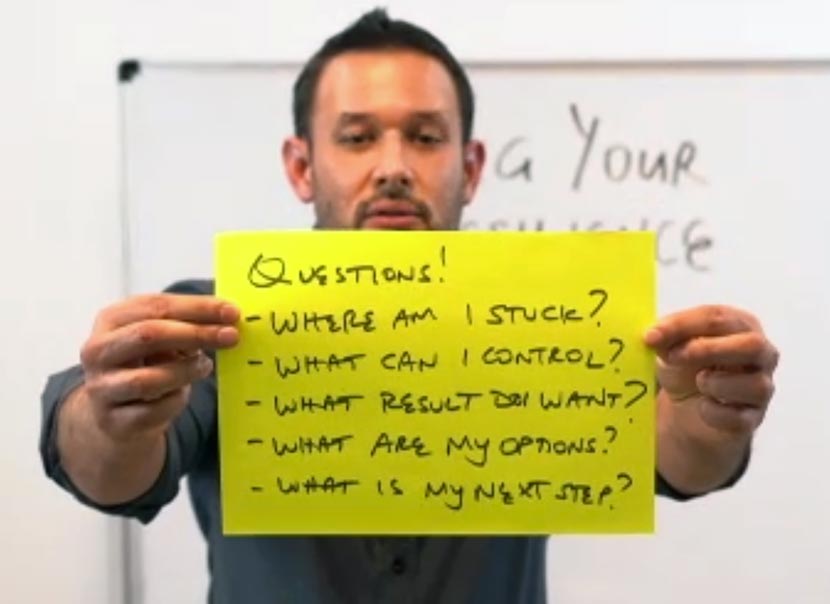
The ability to learn resilience is one reason research has shown that resilience is ordinary, not extraordinary.
Like building a muscle, increasing your resilience takes time and intentionality.
With that in mind – and following last week’s article, which explored what resilience is – here is a five-point plan to help develop it.
1. Develop a social support structure
Do you have a network of people you can reach out to in times of need, where you feel safe and supported to discuss the challenges you may face?
This strategy isn’t always emphasised as a factor in resilience – usually the focus is on improving personal qualities. But it’s so important to connect with someone else and process it with him or her.
The support you have from family, friends and your community is a key factor because they provide not only emotional support or even physical support, such as a helping hand, but also support with the way we think about things.
The positive relationships you have with those around you, and a supportive environment, also play an important role. These relationships offer encouragement and reassurance, and provide role models. They also help us dampen down stress reactions.
So, consider who is in your inner support circle. You need to know you have support in this world, especially when you hit those very difficult times.
2. Embrace change: sh*t happens
What are your first words when something goes wrong? Is it “I knew this would go wrong” or “I knew this would happen”. Or are you immediately able to flip that situation around in your mind and find the positive.
We do this thing when something bad happens, where our first words are “what a gift”. I failed this test – what a gift. I have to deal with this client complaint – what a gift.
Your inner dialogue – how you view things when sh*t happens – is the first and most important aspect of resilience.
There are four steps for change management that need to happen in your head when something bad happens:
Step 1: accept it.
Step 2: find the opportunity.
Step 3: embrace the experience.
Step 4: let it motivate you to take action or make a positive change.
3. Have a purpose
Why is having a sense of purpose so important? A sense of purpose (or meaning) is the motivation that drives you towards a satisfying future. It also helps you to get the most from the things you do and achieve, large and small, right now.
It is a sense of purpose that helps teams accomplish big things together, which may be why it is associated with better physical and mental health. In a way, purpose helps both individuals and the teams survive.
You may think your purpose arises from your special gifts and passions, and it is what sets you apart from other people – that is true. But it is not the entire picture.
Purpose also grows from our connection with each other as you’ll almost certainly find others traveling along with you, hoping to reach the same destination as a community. A prime example is in the workplace – you and your team may have a common sense of purpose for choosing to work in this profession.
Now, how does purpose impact your level of resilience? Purpose not only helps you to find and do things that add meaning to your life, it also helps when things go wrong.
Life presents unforeseen events, such as sickness or accidents, or sometimes, despite trying hard, you may not achieve what you strived for. A healthy sense of purpose helps you to put those events in perspective, then to refocus on the things that are meaningful to you, pick yourself up, and continue to move ahead and enjoy life.
Your sense of purpose can change as you grow older, as you learn new things about the world and about yourself, and as you meet new people and experience new things.
What is important is being able to identify the things that matter to you.
4. Be your own coach and cheerleader
This puts the power back in your court. The power of coaching is that it is focused on continuously moving forward and becoming unstuck.
Being able to move forward despite the challenges we face is an important part of developing resilience. Sometimes we can get stuck, unable to see the way forward – and ruminating on things only makes things worse.
But when we are in the depths of a struggle, it is often hard to see the way forward. That is where coaching comes into play.
Developing the ability to self-coach enables you to move forward and embrace your next challenge – it will help you achieve your goals, bounce back from change or adversity and, therefore, help you feel like you are living in alignment with your purpose.
One thing to remember, you have to frame your response in a positive manner.
A list of questions you can ask yourself are:

You also have to be your own cheerleader. This first means we have to stand up for ourselves and question any limiting beliefs we have about ourselves. A limiting belief is a false belief that you acquire as a result of making an incorrect conclusion about something in life.
It happens to all of us, but these toxic thought traps lead to self-sabotage and hinder your forward progress.
With a little practice and discipline, you can learn to identify as soon as these toxic thoughts spring up, and stop them in their tracks. We have to pay close attention to your internal dialogue, and what thoughts you think. We think between 50,000 and 80,000 thoughts a day, and not all of them are helpful – if anything, a lot of them are self-critical.
If any are not self-serving then tackle them. Give yourself a voice and ask “is this true?” or “where is the proof?”.
Cheering for ourselves with passion, and with a true sense of love and appreciation, is not arrogant; it’s actually required if we’re going to live a life of fulfilment, gratitude and meaning, which will help us bounce back from hardship. Be kind to yourself.
If we start to think of ourselves as our most important ally, friend and, ultimately, cheerleader, we can alter our own internal relationship and begin to count on ourselves in new, inspiring and important ways, which helps us build confidence and bring the power back into your court to bounce back up and keep moving forward.

5. Show self-compassion and have a self-care plan
Have you ever heard the saying: talk to yourself as if you were your best friend? That means offering compassion to yourself like you would a friend – confronting your own internal battle with an attitude of warmth and kindness.
I know it sounds obvious, but those lifestyle factors – such as proper nutrition, enough sleep, drinking plenty of water and regular exercise – all strengthen your body to adapt to stress and reduce the toil of emotions like anxiety or depression.
It’s a fact that if you are well rested and feeling good, you will be better able to face any unexpected challenges that come your way.
Take meditation as an example – show us any high performer in the world and there’s a very good chance he or she uses meditation as a tool.
Additionally, have strategies for unwinding after a tough day. These habits send a signal to your brain that it can slow down, and get rested and ready for sleep.
What is it for you? Have a clear plan in your mind – a walk, cup of tea, reading or dinner? Try to not make it reaching for your phone and scrolling through Instagram or switching on Netflix, as these things have an addictive aspect to them – which means every day becomes a reason to just sit down and veg out, which is not a strategy for resilience.
The other aspect of resilience is this: make sure you maintain your discipline for previous commitments to yourself.
What does that mean? Well, have you ever had a setback, or had something fail or go wrong, and you just threw out everything? For example, this one bad thing happened, so you decide not to go to the gym like planned, or you leave that healthy dinner in the fridge and hit the takeaway instead.
Anyone ever done that?
If some client yells at you, or you have a case that you feel you could have managed better – that is the day to make sure you absolutely stick to your good habits.
Don’t cancel all the good you were going to do as it will only make you feel worse long-term.

Leave a Reply